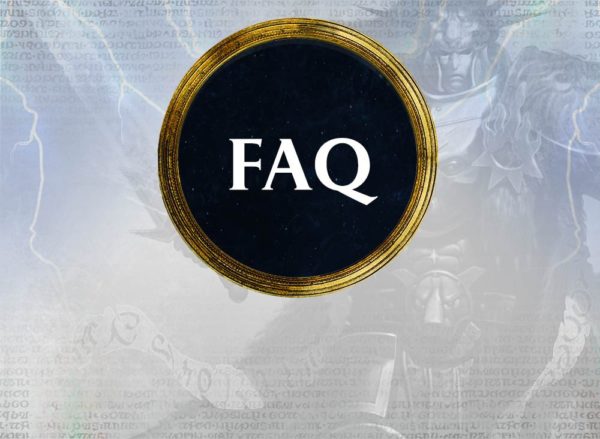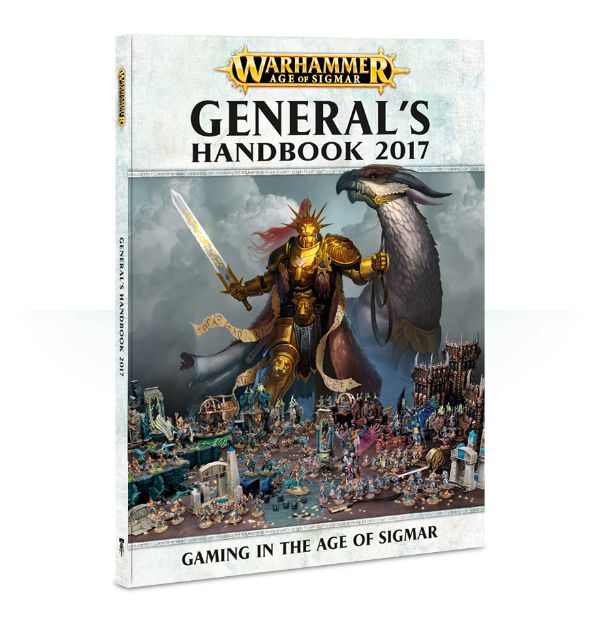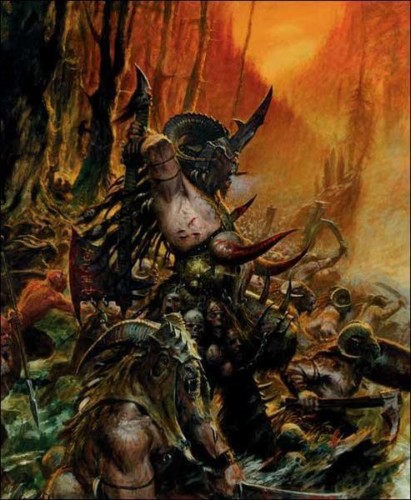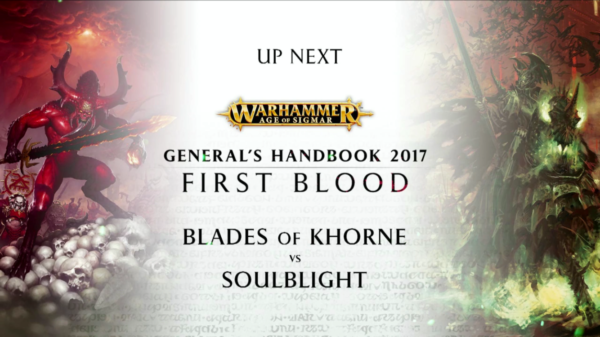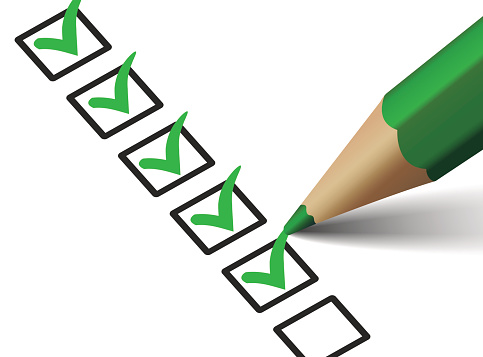[podbean resource=”episode=zxfgf-7088e4″ type=”audio-rectangle” height=”100″ skin=”2″ btn-skin=”109″ share=”1″ fonts=”Helvetica” auto=”0″ download=”0″ rtl=”0″]
This episode sets out the key changes introduced by General’s Handbook 2017 to tournament matched play for Warhammer: Age of Sigmar. As all the Games Workshop advertising has made clear, the game has changed again! While the fundamental principles of the game remain the same, almost all of the key inputs relevant to Age of Sigmar as a tournament game have changed. We have new battleplans, new points values, new allegiance abilities and the new allies mechanic allowing you to retain the benefits of a faction allegiance while supplementing your army with units from other factions.
We have been deluged with an unprecedented amount of information by Games Workshop in the week leading up to this release. We have had daily Warhammer Community articles, Warhammer TV videos on Facebook, daily Twitch streams, and additional podcasts, blogs and forum threads from members of the external playtesting team.
Throughout the week I have tried to collate this information in one handy location, while also providing short bullet point summaries of all the key details from the Twitch stream – you can check them out on this site (First Blood, Order, Chaos, Destruction).
Now, given this information overload, I’ve thought how can we at AoS Shorts help? What can we add that has not already been covered or will be covered by the other Age of Sigmar podcasts and YouTube channels, is not purely speculative, and has value?
The answer, I hope, is this episode on what you need to know if you are preparing for a tournament in a month’s time using General’s Handbook 2017. You may even have one this weekend, for instance if you are in the Mid-West, USA, or next weekend, BLACKOUT in the UK.
I’ll start with a brief recap of all the major changes, comment on how they are likely to impact on list design and finish with some thoughts about how General’s Handbook 2017 will affect tournament play (this part may be little more than informed speculation, but I hope you’ll indulge me). Please note, that this episode has been written and recorded without seeing the new FAQs, compendium points and Forgeworld changes that are promised on release day. So with that proviso, on with the show.
Update: the FAQ and points are now up – you can find them in one handy text-searchable and indexed PDF in the resources section.
General’s Handbook 2017: the top 10 changes you need to know!
Everyone loves a good top 10 list and it seems appropriate for this show.
1. New Rules of One
The General’s Handbook 2017 amends the existing Rules of One and adds two more.
- The roll for priority at the beginning of each battle round cannot be modified or re-rolled. However, abilities such as Archaon’s which allow you to know who will have priority in advance, still work because they do not modify or re-roll the priority roll. The Coven Throne is another unit unaffected by this change to the Rule of One. For more information on the priority roll and how to manage it to the best effect in game, see my previous priority roll article but bear in mind that part of it is now invalidated by this rule change.
- No artefact of power (or similarly named items) can be taken more than once in the same army. However, prayers remain immune from the Rules of One and certain abilities can still stack (as always, read the wording of the abilities carefully).
- Amendment: as well as a roll of 1 always failing to hit or wound, a roll of a 6 will now always succeed. Games Workshop also took the opportunity here to reinforce the often mis-played core rule that re-rolls occur before modifiers apply. Given how often this rule causes confusion, I’ll do a separate show on the topic in the future.
2. New Battleplans
There are six new Pitched Battles designed to test the tactical skills of players in a variety of situations: Knife to the Heart, TOTAL CONQUEST!, Duality of Death, Battle for the Pass, Starstrike, and Scorched Earth. These battleplans are intended as additions to the existing six Pitched Battleplans in the General’s Handbook. Some of the new battleplans:
- are amended versions of the older missions;
- favour new list builds (predominately units with 20+ models, but also behemoths); and
- one (Scorched Earth) introduces a new mechanic where you can destroy objectives to take a chance at scoring more points.
3. Allies
You can now add Allies to your armies. This mechanic allows you to select units from other factions in your army without foregoing the benefits of your faction allegiance abilities (such as spells, artefacts, command traits, battle traits etc.) The General’s Handbook contains a table of how many allies you can take, depending on the size of your army (for instance, you can use 400 points of your 2000 points army on allies).
Each faction has its own allies table of factions it can ally with. These choices have largely been made to fit with the lore of Age of Sigmar. For instance, Sylvaneth can take Wanderers and Stormcast Eternals as their allies.
Allies will allow you to fill holes in your army list to cover your weaknesses or emphasise your strengths – add wizards, artillery, behemoths etc. as required. However, note that allies can’t be your general or count towards your battleline requirements. Allies do count for your maximum number of leaders, behemoths and artillery.
Finally allies don’t gain the keyword of your main faction allegiance, so can’t be given artefacts or command traits and in most cases won’t benefit from allegiance abilities as they don’t have the necessary keywords. This is the same approach as with the mixed-faction battalions in previous battletomes. There are some exceptions, for instance, in Slaves to Darkness there is an ability which affects a CHAOS HERO, which could be one of your allies.
4. New allegiance abilities
The General’s Handbook contains a whole host of new options for certain Age of Sigmar factions. These options are intended to provide more variety to factions and tie these factions even closer to their lore and background. The factions which benefit are Darkling Covens, Dispossessed, Free Peoples, Fyreslayers, Seraphon, Wanderers, Brayherd, Slaanesh, Slaves to Darkness, Pestilens, Skryre, Flesh-Eater Courts, Nighthaunt, Soulblight, and Ironjawz. All of these additions add flavour – for example, herdstones for Brayherd, the Wanderers’ ability to retreat and shoot and the great plagues of Pestilens.
5.Changes to existing allegiance abilities
There have been significant changes to existing allegiance abilities and artefacts. Popular choices for Chaos, Destruction and Death have all been altered. We understand the intention behind the change to be to increase variety by removing obvious choices.
6. Mounts
The rules team has added a new rule regarding how abilities affect mounts. Any command abilities or magical artefacts can only be used to affect attacks made by the hero, and have no effect on attacks made by their mount unless specifically stated otherwise. I’ll be interested to see if there is an FAQ which explains whether an ability that refers to “the model” is considered as specifically including the mount or whether it has to say it applies to the hero and its mount.
7. Changes to battlefield roles
Games Workshop has reviewed the pitched battle profiles for every unit in Warhammer Age of Sigmar and changed many of them for General’s Handbook 2017. There are now far more choices for your general and more units which will count as battleline, if your army is a particular allegiance (“battleline, if” units) – for instance, Daughters of Khaine can have Doomfire Warlocks and Sisters of Slaughter as battleline units. All of these changes are indicated by the red star you see alongside the entries in the pitched battle profiles.
8. Massive Regiments
Massive Regiments is a new mechanic in which certain units become cheaper (per model) if you field the unit at maximum size. For instance, Dryads are 100 points for 10, but only 270 points if you take 30 in the same unit. The general rule is that every standard infantry unit in the game has access to the rule. Infantry units with missile weapons don’t benefit from the Massive Regiments rule (except for a few limited exceptions, skinks, gutter and night runners).
As I get on to later, expect to see more large units on the tabletop.
9. Points changes
The points for a substantial number of units and battalions in Warhammer: Age of Sigmar have been changed – either up (Skyfires, Kurnoth Hunters) or down (Nagash and Jabberslythes).
What has probably received the most attention this week is that there have been significant increases in the points costs for battalions. In many cases increasing by a multiple of 2, 3 or more! These increases have been to reflect the benefits to an army of receiving an extra artefact and the ability to have fewer drops (see the deployment show for how battalions provide substantial benefits to deployment and dictating the first turn). To understand the thinking behind the change, I highly recommend watching the Jervis Johnson interview on Warhammer Live this week, or reading my summary.
10. New FAQ, Compendium and Forgeworld points
Finally, Games Workshop have confirmed that there will be an FAQ published on Warhammer Community on the release date, alongside a PDF of pitched battle profiles for compendium units and new Forgeworld points and warscrolls.
Preparing for your General’s Handbook 2017 tournament
So, what does all this mean for you if you are preparing for your first General’s Handbook 2017 tournament this month? The principles of good list design are unchanged (I’ve covered them in a previous episode) – you need to consider reach, board control, resilience, damage output and risk – but your inputs to that assessment have changed. So to can we expect a change to the global and local tournament meta (the likely lists that you will face at a tournament and need to account for). So how do you solve this new puzzle?
At the outset the key drivers for the changes are the new battleplans and the Massive Regiments rule. After those, the introduction of allies and the changes to the allegiance abilities are likely to have the greatest impact on your tournament meta.
In addition to the previous list design factors emphasised by the pitched battle battleplans, you now need to consider behemoths and large units.
Behemoths – either bring one, or learn how to deal with them
You need to consider behemoths for the Duality of Death scenario – either in adding them to your army, or being able to counter those brought by your opponent. For example, behemoths can either be tied up by your mobile disposable units or have their effectiveness reduced by chipping off wounds at range.
Behemoths are not mandatory, as heroes can still score in the scenario, but we can expect to see more of them.
Large units – making the most of your units with 20+ models
You are also likely to need at least one large unit of 30+ models. Two of the scenarios, Total Conquest and Battle for the Pass, have an additional rule that allows a unit of 20+ models to seize control of an objective, even if the opponent has more models around the objective (if they are from different units). There are important things to note:
- As Ben explained on Bad Dice Daily, you only need to have one model from that 20+ unit in range, to seize control of the objective.
- You can only control one objective with a unit. So you can’t string the unit to claim several objectives. However, if the unit is resilient, you are still incentivised to extend the unit out to control board space and block your opponent from scoring the other objective. Denial can be just as important as positively holding an objective.
- Consider ways that you can support and reinforce that large unit – a large unit is a single target for buffs and is one combat activation – so make use of it. Also prepare for ways that your opponent will try to take down that unit, by adding battleshock protection (whether through Inspiring Presence, or the Order and Free Peoples allegiance abilities for example)
- It is an advantage if that large unit is relatively mobile (or can be moved by a spell or ability). You need to get onto objectives quickly and force your opponent to try and dislodge you.
Dealing with large units
Consider how you will be able to remove or minimise your opponent’s resilient large units:
- do you have Drycha, a Gaunt Summoner, Acolytes or Plagueclaw Catapults which have attacks aimed at large units or bonuses when targeting large units?
- Remember, you don’t need to destroy the entire unit – it may be enough to simply reduce it below 20 models in order to remove the scenario benefits or the extra benefits on its warscroll (such as Grots which get benefits based on the size of the unit).
- can you reduce their bravery and have them lose more models from battleshock?
- can you snipe out their support characters – such as the Free Peoples general which is making all the units nearby immune to battleshock?
- finally, can you block up the large unit with multiple small units of your own? can you pin them in place by tagging them on the end of the line with a resilient and mobile unit such as Kurnoth Hunters?
Allies
As I’ve said earlier, use allies to fill gaps in your army – units that perform a role you previously did not have access to. Need a large resilient block? need some cheap mobile and disposable units? need a ranged threat, for instance spear chukkas in an Ironjawz army? need a way to take out large hordes?
Also consider allies for reinforcing the key units in your main faction – for instance, with additional buff spells or abilities which may apply. Just check the keywords to make sure the combination will work first!
Allies are the best way of achieving these ends.
Crystal ball time – the tournament meta
Now we reach the crystal ball part of the show. As I’ve counselled earlier this week, it is important not to jump to conclusions based on leaks or information in isolation. While we can make some informed comments about the likely future tournament meta, no one can accurately predict what will happen once a 1,000 tournament gamers get hold of the General’s Handbook 2017 and start trying to break the game apart.
However, I know many of you listeners are hanging out for some predictions. So these comments are offered with a large heaping of salt:
Likely top armies
- it seems to us that the following armies remain strong:
- Blades of Khorne – cheaper Bloodletters, Reavers and Bloodthirsters;
- Disciples of Tzeentch – cheaper Tzaangors, horrors, despite the changes to Skyfires and the Lord of War;
- Kharadron Overlords – still able to field powerful lists despite the change to Thunderers and Khemists – expect lots of shots from Arkanaut Company;
Impact on mixed Grand Alliance forces
- mixed Chaos, Destruction and Death have all been impacted by changes to their allegiance abilities which will require them to come up with more options.
- Chaos has had changes to Lord of War and Crown of Command;
- Destruction has had a major impact with the change to Rampaging Destroyers; and
- Death has been affected by the reduced range of the Deathless Minions and the Ruler of the Night rules (presumably to balance the benefits from the Massive Regiments rule).
- These have been off-set by allied options, more faction allegiance abilities and some tweaks to battlefield roles and points. It is possible that many of these forces will instead move to single-faction armies with allied contingents. Keep an eye out for the Nurgle Cycle of Life abilities with the Blightwar box.
- By contrast, Order seems to be a significant winner with the introduction of new faction allegiance abilities and innate protection to battleshock for large units. Seraphon look particularly interesting – and given their magical dominance (with Slaan able to unbind from anywhere on the table) make sure your plans don’t rely on getting that one crucial spell off!
- Plus every Order faction has the ability to have Stormcast as allies – lots of options.
Other comments
- Movement as always in Age of Sigmar is key – both Wanderers and Seraphon have benefited from new abilities allowing them to move units where they need to be, or out of a difficult situation.
- While I haven’t worked through all the possibilities, there seems to be some interesting tweaks to reinforcement points – check out the Ring of Immortality, the Slaan artefacts, and Slaves to Darkness ability to give you a free daemon prince on a 12 🙂
With the new scenarios and the possibility of larger units on the table it is more important than ever to be prepared with your army and the rules at a tournament game. You need to move efficiently in order to complete your games on time – I recorded a range of tips and suggestions for this in a previous show. This is a fundamental matter of fairness given that some of the battleplans, for instance Starstrike, really need to be played for all 5 turns.
Concluding thought
As a final comment, enjoy the extra options and variety to create armies you enjoy. It’s easy to get caught up with what is “tournament viable” or will succeed at the bleeding edge competitive level. However, the reality of most tournaments is that you will not be exposed to the bleeding edge of what is theoretically possible. It costs time and money to build an army. You will most likely face a range of armies from your existing cohort of local players. Those players now have more options and it will be great to see more thematic tools for Slaanesh, Seraphon, Fyreslayers etc. Ultimately the goal for the General’s Handbook 2017 is to allow you to put a wider variety of troops on the table.
As always, you can find me on Twitter, on Facebook, and on TGA. Let me know what you think 🙂
Resources





